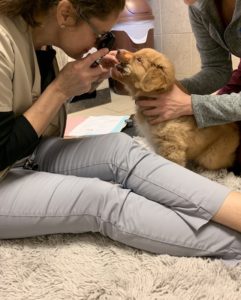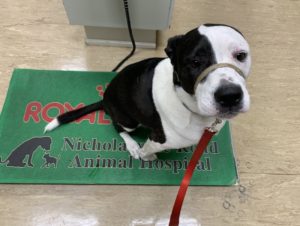by Mandy | Dec 7, 2022 | Training advice
The Training Didn’t Work
I hear it in casual conversation, at the vet’s office, in my daycare, and even from my own clients. “The training didn’t work.”
I must admit, I’m guilty of saying the same thing. With my very first dog, I found myself saying, “the training didn’t work”. I had a little Jack Russell mix named Scooter and he was the dog I did everything wrong with. I’m sorry Scooter, I didn’t know any better, I was learning.
Why didn’t Scooter’s training work? It was the wrong kind of training for him and for me. His training was based on punishment. If he didn’t sit, I was told to jerk on his leash in a swift upward motion until his butt met the floor. Once he sat I was to “reward” him. I wasn’t told how to reward him or how to determine a reward for him. Over time neither one of us enjoyed training. He became a biter due to the stress of impending correction. I became frustrated and increased my corrections.
The next example of why training didn’t work is with all my dogs. I’ve wanted to teach a flashy, formal heel for years. I’ve taken classes, lessons, and watched videos. I don’t have one single dog that will formally heel with a bouncy step and their head up. Why doesn’t the training work? It’s me. Hi. I’m the problem. It’s me. I’ve never followed through. Turns out that only taking bits and pieces of training instr uction doesn’t actually work. You also have to actually do the work and do the work consistently. This means finding time to work with my dogs consistently. Did the instruction of the trainers I worked with fail? No. Did the methods not work? Don’t know. I never followed through.
uction doesn’t actually work. You also have to actually do the work and do the work consistently. This means finding time to work with my dogs consistently. Did the instruction of the trainers I worked with fail? No. Did the methods not work? Don’t know. I never followed through.
Look at the situation with your dog. Did the training not work because of the method or did the training not work because you didn’t put the commitment into it?
According to a study done by Phillippa Lally, a health psychology researcher, “on average it takes 18-254 days for people to form a new habit.” The drastic variability is due to person, the behavior, and the circumstances. The full study was published in the European Journal of Social Psychology.
How to be Successful Training Your Dog
- Does your trainer motivate you and your dog?
- Do you look forward to training sessions with your dog?
- Are you setting attainable goals.
- Why are you training the behaviors you are? Are they must haves or nice to haves?
- Are you working on true training issues or does your dog need behavior modification?
“Train Don’t Complain”
Mandy Eakins CPDT-KA, CPDT-KA
by Mandy | Jan 17, 2020 | Training advice
While a dog trainer is an important part of the dog care team, there are some things trainers can’t fix. This doesn’t mean they can’t be helpful and it doesn’t mean they don’t understand. What it means is they may need the additional support of a veterinarian or veterinary behaviorist and in all cases they need 100% dedication of the owner to implement the management and training for it to be successful.
What a Trainer Can’t Fix
- Dogs that don’t like other dogs.
- It’s not possible to make dogs like each other, just like it’s not possible to make people like each. Dogs that show aggression or fear to other dogs are managed. While it may be possible to work with a dog to make them more comfortable around other dogs, it doesn’t mean they want to interact or play with other dogs.
- Your dog’s behavior.
- We can’t fix behavior when owners don’t contribute to the training as suggested. To change a dog’s behavior, owners have to change their behavior. Owners must be committed to training lessons, classes, and practice. Your trainer doesn’t live with your dog. They spend very little time with your dog. It’s up to you to learn from your trainer and implement the techniques on a day to day basis.
- Genetics.
- Before bringing a dog into your home, you should know the function of the breed or breeds of the dog. Breed club websites are a great place to learn about the characteristics of breeds. Is the dog bred to herd? Be prepared to manage the desire to chase and nip. Is the dog bred to guard? Be prepared to have a dog that doesn’t make friends quickly. Understand that mix breeds don’t mean you will get the best of both breeds. You can just as easily get the worst of both breeds. Best bet. Contact a trainer BEFORE you get a dog and let them help you choose your next best friend.
- Natural developmental stages.
- Puppies nip and bite. Adolescent dogs are 4 legged teenagers; they make poor choices and have a hard time controlling impulses. What a trainer can do is help you manage these stages.
- Aggression
Aggression is managed. It’s not cured. The sad truth is that aggression is an illness and can be terminal. While a qualified trainer may be able to help an owner successfully manage their dog, there is no guarantee that a dog won’t bite. Every dog that has a mouth and teeth has the ability to bite, some dogs use that ability more than others.  Train Don’t Complain,
Train Don’t Complain,
Mandy Eakins KPA CTP, CPDT-KA
Manners Matter Dog Training and Daycare, LLC
by Mandy | Jan 10, 2020 | Training advice
 Most veterinarians understand the importance of having a good trainer as part of their team. Working with a qualified trainer can not only keep dogs in their homes, but they can also help a family choose a new dog. Dog trainers are also a great resource to assist with recovery and healing through the use of mental enrichment while on crate rest or limited activity. We can also help ease the stress of scary vet visits that may keep owners from seeking the medical treatment their dog needs. If I had a chance to to talk with veterinarians, this is the information I would like them to know.
Most veterinarians understand the importance of having a good trainer as part of their team. Working with a qualified trainer can not only keep dogs in their homes, but they can also help a family choose a new dog. Dog trainers are also a great resource to assist with recovery and healing through the use of mental enrichment while on crate rest or limited activity. We can also help ease the stress of scary vet visits that may keep owners from seeking the medical treatment their dog needs. If I had a chance to to talk with veterinarians, this is the information I would like them to know.
What I Want Veterinarians to Know About Dog Trainers
- Trainers can help keep clients in your practice.
- It’s true. Most dogs are turned into shelters and rescues because of undesired behaviors. What happens then those dogs go to shelters or other homes? They come out of the veterinary practice. Working with a qualified trainer helps keep those dogs in their homes and in your practice. See below for how to find that qualified trainer.
- Not all trainers are the same.
- I know I sound like a broken record on this one because I say it all. the. time. But it’s so true. Take the time to interview trainers that you will be referring too. Call trainers in to do a 15 minute meet and greet and ask about their methods, and education. Do their standards and values match those of your clinic? Are they focusing on the human animal bond using the least invasive methods available? Most trainers give a discount to veterinary professionals. If you can’t take a class, go observe once or twice. Reach out to your local trainers or take the time to respond to their requests for meet and greets or lunch and learns. Good trainers want to work with the veterinary team as part of a training or behavior modification plan. The American Veterinary Society of Animal Behavior has a great online resource for “How to Choose A Trainer”
- Do you know what certifications mean? Do you know what certifications are out there? Below is a list of the most common certifications and professional organizations. You can check out my credentials here if you are interested. This is a great place to start when looking for trainers in your area as most of these organizations keep an online list of qualified trainers. While not all trainers pay to keep a listing online with the group, look for these titles on business cards, handouts, etc. Each group below has their own certification guidelines. It’s usually a quick process to read their standards and find out what testing or evaluation has been done for a trainer to hold one or more of these titles.
- Many behavioral issues are due to medical issues.
- Dr. Amy Pike, DVM, DAVCB has a great read, “Medical Causes of Behavior Problems in Dogs and Cats”. Trainers often see dogs where they are most comfortable and will exhibit symptoms that might not surface in an exam room. It’s also not uncommon for clients to share information or concerns that they wouldn’t normally bring up in a veterinary visit. Encourage the trainers you refer to to share progress or changes with you throughout their training plans. Dogs that have a history of chronic pain or pain associated with a particular incident may need the help of a qualified trainer to counter condition or desensitize that association. If you have a patient that has suffered an injury or is being treated for chronic pain, suggest a trainer to help with any behaviors that may be a result of that pain.
- Training for recovering patients and crate rest cases.
- Occasionally it’s necessary for dogs and even puppies to have to be put on limited activity and or crate rest. For puppies this can be detrimental to their mental development and socialization. For adult dogs this is incredibly boring and can create undesired behaviors such as destruction or even self mutilation. Training doesn’t have to be physical to be effective. There are many crate games, and low activity games that can both stimulate the mind while being easy on a recovering body. One of my favorite cases was an older puppy that was unfortunately hit by a car the week before class started. The puppy had a broken leg and was on crate rest. We did the entire 6 week class with the puppy in a crate. She learned all her basics in a crate and YES, the behaviors carried over outside of the crate. Her leg healed perfectly and she didn’t miss out on training during a critical time in her development.
- Hard To Treat Patient

- Every vet has a story about those nightmare patients. The ones who are extremely fearful and make even the most simple of procedures a costly and unpleasant experience for everyone involved. Dogs can be taught to accept low stress blood draws, as seen in this video, low stress nail trims as seen in this video, as well as many other common veterinary procedures like ear cleaning, eye drops and vaccines. Our training center offers a class specifically designed to teach these techniques to hopefully make stressful visits a little less so. More information about that class is available on our scheduling page. I have been thankful on more than one occasion that my dogs are comfortable with veterinary procedures. It has given me time with them that I wouldn’t have otherwise had and has made recovery from major surgeries easier.
- Prevention
- Getting dogs into socialization and training early is key. Quoted from The American Veterinary Society of Animal Behavior, “In general, puppies can start puppy socialization classes as early as 7-8 weeks of age. Puppies should receive a minimum of one set of vaccines at least 7 days prior to the first class and a first deworming. They should kept up to date on vaccines throughout the class.” While it is still commonly suggested by many veterinarians, puppies do not and should not wait until all vaccines have been given to start training.
- New dogs. Established clients that are thinking of getting another dog should be put in contact with a trainer to help with the new addition. Many trainers can even help owners make choices on finding a reputable breeder, shelter, or rescue group. Trainers can also help the owners introduce new housemates safely, giving the best chance for a successful addition to the family. Our Puppy Head Start class is open enrollment, offering class two nights a week. It is by far our most important of the classes we offer.
There are occasions when the situations are difficult and we need an outside opinion or assessment. In cases of severe anxiety, fear, or aggression, a Veterinary Behaviorist can be very helpful. While not available in all areas, most will consult with a general practice vet office for little to no charge. A veterinary behaviorist can help with medication choices and protocols. Research is happening all the time in the field of behavior and there are so many options for treatment. To find the nearest Veterinary Behaviorist, check out the American College of Veterinary Behaviorists to find the nearest one to your area.

by Mandy | Mar 19, 2019 | Training advice
Expectations – It’s not what you expect
I’ve been training dogs for over 20 years. Looking back on where I was versus where I am now is still unbelievable to me. I guess deep down I always knew I would be involved with animals somehow, but making it a career in the capacity I have was never on my radar. I’ve developed from a dog owner to a dog trainer…….when did that happen? It happened the moment my then boyfriend, now husband, and I brought home our first puppy. A little Jack Russell Terrier mix named Scooter.
It would be nice if these little thieves of our hearts came to us knowing it all. They don’t. They need to be trained to be appreciated, well mannered, members of our families. So how do make that happen? Well if you are like I was, you muddle through for a while and then realize you need help. You need a dog trainer. You find a trainer (how to do that will be in another post) and arrive at your first lesson or class waiting for the magic to happen. The magic of the trainer to train your dog. WRONG!!!
The expectation of having the dog trainer train your dog is the wrong one. The job of the dog trainer is to coach and teach you how to manage, understand and work with your dog. Are you staring at the screen with blinky eyes? That’s right, the person you just hired is not there to train your dog. They are there to coach you how to work with and understand your dog.
I’ll try to put this into perspective. My Basic Manners class is a 6 week course, 5 of those weeks the dogs are in class. Each class is roughly an hour long. There are a total of 1,008 hours in those 6 weeks, you are with me for 6 of those hours; your dog is there 5. You share the class with 7 other people and their dogs. It is impossible for one person to fully train 8 dogs in 5 hours.
What should your expectation be for something like a group class? You should expect to come out of a group class with a good understanding of basic training skills. You should have an understanding of how your dog learns, what their motivators and reinforcers are, and how to use those tools to get desired behaviors out of your dog. You and your dog should have positive experiences around other dogs and people in a group class. Lastly, you should have an opportunity to practice what is being taught and receive feedback from the trainer.
It really is like school. You come to class to learn the lessons, you go home and do the homework, you come back and show your understanding of the material being taught. The test is your day to day life with the dog. If you aren’t seeing improvement you might need to increase your study time or ask for a tutoring session (private lesson).
Dog training really is about what YOU put into it. It takes time, repetition, and patience to get the well-mannered dog you envisioned. Expect it to be a journey, a journey that will teach you about love, respect, and build a relationship like you never thought you would have.
Train don’t complain,
Mandy Eakins KPA CTP, CPDT-KA, FP-MT
by Mandy | Mar 12, 2019 | Training advice
What is Modern, Force-Free Dog Training?
Here it is….my first official blog post. I’ve got lots of topics to cover as I dive into this project, but I thought it would be best to start with the training method. What is modern, force free dog training?
In short, modern dog training, also called force free dog training, is training without the use of force, intimidation, fear, or pain. The training is about teaching—and learning— through relationship building, trust, respect and understanding.
Understanding is the most important part of dog training. Knowing why your dog behaves in a particular way is the foundation for changing that behavior. I find that most problem behaviors occur because we do not understand why the behavior is occurring in the first place.
Let’s briefly look at how dogs learn. Dogs learn a lot like we do. They repeat what they are rewarded for and they avoid or disengage from what isn’t reinforcing. Need an example?Consider counter surfing. The dog puts his paws up on the kitchen counter and gets a lick of toast crumbs and a dribble of jelly. The dog learns that the kitchen counter is a rewarding place and repeats the behavior. Putting paws on a counter is reinforced by getting a lick of leftovers. Understanding the dog has a certain level of curiosity and if physically able, I think we can all agree, he will at least investigate the counter again.
The traditional way of handling this behavior would be as follows: owner catches dog with his paws on the counter; owner yells or swats at the dog; dog gets off the counter and walks toward owner. The dog repeats the behavior the next day; owner verbally scolds dog for being on the counter, this time with a little collar shake; dog sulks away from the owner. What the owner might notice over time is the dog does not get on the counter in their presence, but still gets on the counter when no one is looking. What has the dog potentially paired the punishment with, their behavior or the presence of the owner? What could be possible fall out from using this approach? Could the dog become fearful of the owner?
You can see where this is going. The dog has paired the punishment with the owner and associating the punishment with the presence of the owner becomes a twofold problem. Certainly the dog may continue to get on the counter when the owner is not around, but the problem is more complex than that. The may may also lose trust in the owner or worse, become fearful of the owner.
A more modern approach to this unwanted behavior would be to stop it before it starts or teach an alternative behavior that is not compatible with getting up on the counter.
Here are some possibilities
- use barriers so the dog is not allowed in the area unsupervised
- teach an automatic sit when the owner and dog are near counters together
- teach the dog to stay behind a threshold or other boundary
- teaching the dog a “go to place” behavior
- be diligent about not leaving potential reinforcers on the counter should the dog decide to investigate
Modern, force free dog training is not about becoming a Pez dispenser of treats. It’s about teaching the animal appropriate behaviors through use of reinforcers the dog finds valuable and managing the environment around the dog while training is taking place. Focus on building a solid relationship of trust and setting the dog up to succeed and learn, not fail and be punished.
Until next time,
Train don’t complain!
Mandy Eakins KPA CTP, CPDT-KA, FP-MT
www.mannersmatterky.com
 uction doesn’t actually work. You also have to actually do the work and do the work consistently. This means finding time to work with my dogs consistently. Did the instruction of the trainers I worked with fail? No. Did the methods not work? Don’t know. I never followed through.
uction doesn’t actually work. You also have to actually do the work and do the work consistently. This means finding time to work with my dogs consistently. Did the instruction of the trainers I worked with fail? No. Did the methods not work? Don’t know. I never followed through. 

 Most veterinarians understand the importance of having a good trainer as part of their team. Working with a qualified trainer can not only keep dogs in their homes, but they can also help a family choose a new dog. Dog trainers are also a great resource to assist with recovery and healing through the use of mental enrichment while on crate rest or limited activity. We can also help ease the stress of scary vet visits that may keep owners from seeking the medical treatment their dog needs. If I had a chance to to talk with veterinarians, this is the information I would like them to know.
Most veterinarians understand the importance of having a good trainer as part of their team. Working with a qualified trainer can not only keep dogs in their homes, but they can also help a family choose a new dog. Dog trainers are also a great resource to assist with recovery and healing through the use of mental enrichment while on crate rest or limited activity. We can also help ease the stress of scary vet visits that may keep owners from seeking the medical treatment their dog needs. If I had a chance to to talk with veterinarians, this is the information I would like them to know.
